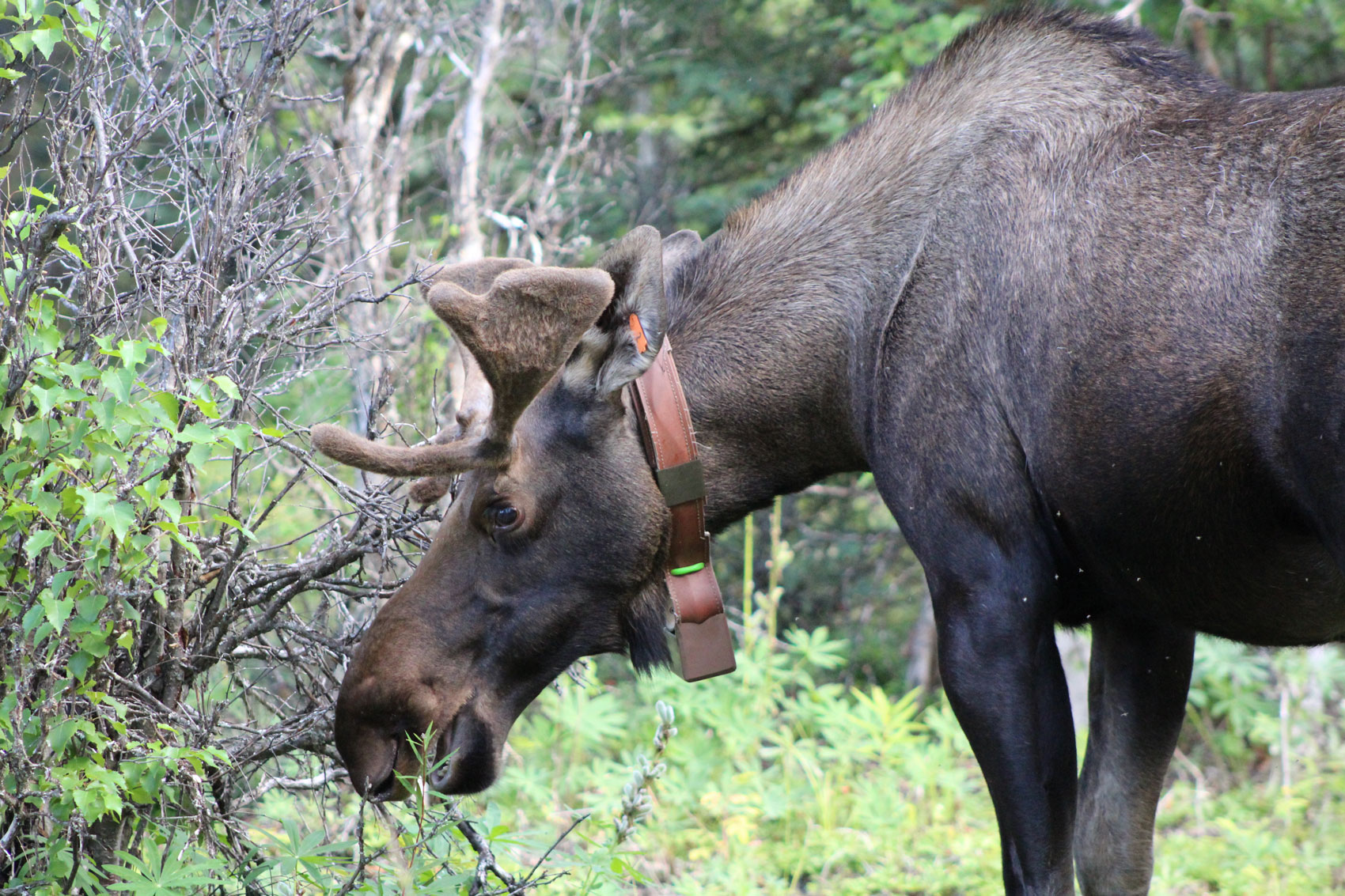A vegetation sampling technique to estimate available moose forage biomass and nutritional quality on the Kenai Peninsula, Alaska

(photo credit ADF&G 2024 Daniel P. Thompson)
Overview
Quantifying moose forage on the landscape is challenging but can provide managers with an indication of habitat quality. This moose foraging sampling technique builds off established vegetation sampling methods; however, we have adapted the methods to incorporate moose foraging ecology. We document moose forage quality and quantity at 5 time periods associated with moose energetic demands and plant characteristics. The products of this moose forage sampling method are available digestible energy (MJ / ha) and digestible protein (kg / ha) for each area of interest. This method can provide managers with a quick assessment of moose forage resources after landscape scale disturbances (e.g., fire), providing perspective on one aspect of moose population dynamics in the boreal forest.
ArcGIS Survey123 field data collection template
An ArcGIS Survey123 template built in Microsoft Excel can be loaded into ArcGIS Survey 123 Connect desktop application and customized to add in field crew names, plot ID’s, and additional vegetation species. With an ArcGIS online account, the ArcGIS Survey 123 template can then be uploaded to an ArcGIS online account, which will allow the survey to be downloaded to mobile ArcGIS Survey123 app on tablets or phones for field data collection. Data, including photographs, are transmitted from the ArcGIS Survey123 mobile app to ArcGIS online where it is stored and can be downloaded.
Moose Forage Quantity Survey123 Template
Moose foraging videos
Wildlife biologists at the Kenai Moose Research Center have documented foraging behaviors of tractable moose during different seasons in the boreal forest. This compilation of videos shows what plant species, and what parts of those plants, moose are consuming. This information is useful when assessing the available biomass of forage for moose on the landscape.
April foraging behavior
April – Paper birch
Example of how moose at the Kenai Moose Research Center browse on paper stems in April. Moose crop lateral stems
April – Lowbush Cranberries
Example of how moose at the Kenai Moose Research Center forage on lowbush cranberries in April. Moose select both stems and leaves during this time period.
April – Lowbush Cranberries
Example of how moose at the Kenai Moose Research Center forage on lowbush cranberries in April. Moose select both stems and leaves during this time period.
April – Lowbush Cranberries
Example of how moose at the Kenai Moose Research Center forage on lowbush cranberries in April. Moose select both stems and leaves during this time period.
June foraging behavior
June – Wild Rose
Example of how moose at the Kenai Moose Research Center forage on wild rose in June. Moose select only the leaves during this time period.
June – Wild Rose
Example of how moose at the Kenai Moose Research Center forage on wild rose in June. Moose select only the leaves during this time period.
June - Highbush cranberries
Example of how moose at the Kenai Moose Research Center forage on highbush cranberries in June. Moose select only the leaves during this time period.
June – Fireweed
Example of how moose at the Kenai Moose Research Center forage on fireweed in June. Moose pull fireweed from the ground including the white stem during this time period.
July foraging behavior
July – Fireweed
Description: Example of how moose at the Kenai Moose Research Center forage on fireweed in July. Moose crop the top ~20cm of fireweed stalks during this time period.
July – Fireweed
Example of how moose at the Kenai Moose Research Center forage on fireweed in July. Moose crop the top ~20cm of fireweed stalks during this time period.
July – Aspen
Example of how moose at the Kenai Moose Research Center forage on aspen in July. Moose select only the leaves during this time period.
July - Foraging examples
Example of how moose at the Kenai Moose Research Center forage on aspen, paper birch, and fireweed in July. Moose select only the leaves during this time period of aspen and paper birch and crop the top ~20cm of fireweed stalks.
August foraging behavior
August – Paper birch
Example of how moose at the Kenai Moose Research Center forage on paper birch in August. Moose select only the leaves during this time period.
August – Aspen
Example of how moose at the Kenai Moose Research Center forage on aspen in August. Moose select only the leaves during this time period.
October foraging behavior
October – Dogwood
Example of how moose at the Kenai Moose Research Center forage on dogwood in October. Moose select both stems and leaves during this time period.
October – Dogwood
Example of how moose at the Kenai Moose Research Center forage on dogwood in October. Moose select both stems and leaves during this time period.
October – Dogwood
Example of how moose at the Kenai Moose Research Center forage on dogwood in October. Moose select both stems and leaves during this time period.
October – Exposing cranberries
Example of how to expose cranberries covered in snow (
October – Lowbush Cranberries
Example of how moose at the Kenai Moose Research Center forage on lowbush cranberries in October. Moose select both stems and leaves during this time period.
October – Lowbush Cranberries
Example of how moose at the Kenai Moose Research Center forage on lowbush cranberries in October. Moose select both stems and leaves during this time period.
October – Dogwood
Example of how moose at the Kenai Moose Research Center forage on dogwood in October. Moose select both stems and leaves during this time period.
